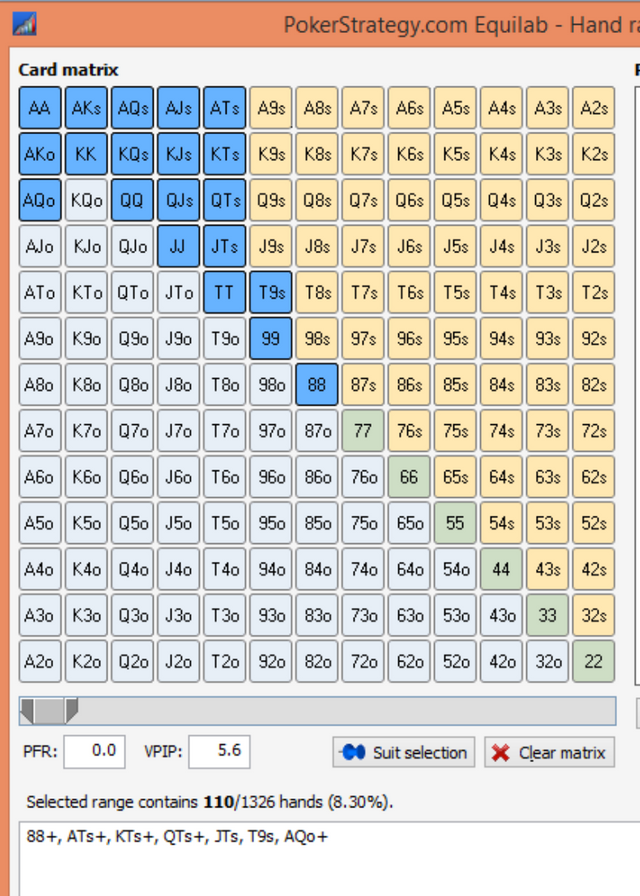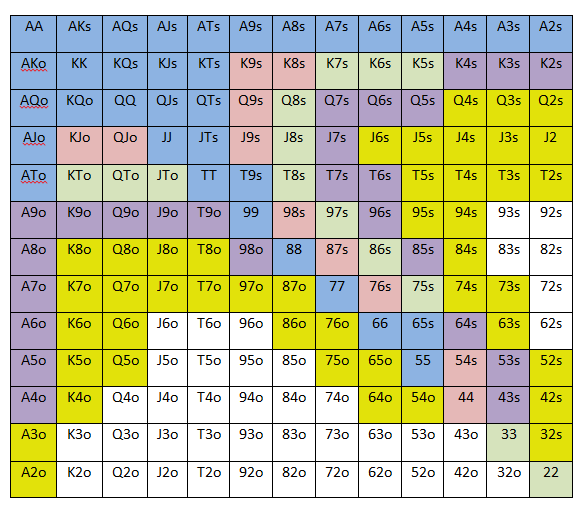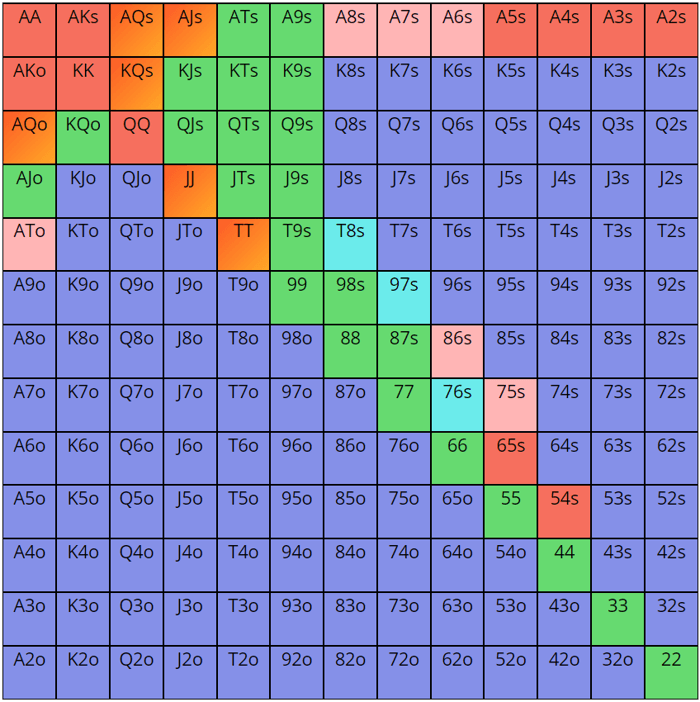Poker When To Raise Pre Flop

If you raise preflop from early position with something like 99, you reduce the number of players that will see the flop and make it more likely that your hand will be best even if an overcard falls. With no raise, hands like KJ or A10 will be more likely to come in and beat you if an overcard does flop.
- A player does not necessarily have to be the cold-caller preflop and face a flop c-bet in order to bluff-raise the flop. They might actually be the preflop aggressor, decide to skip their cbet OOP and go for a check/raise. In reality good players should be doing this almost as often as they check/raise.
- Jan 14, 2020 This preflop checklist contains just 6 things that will keep you focused on the right information preflop and help you decide if you should fold, limp-behind, or attack with a big raise. Most players build their preflop strategy solely around a hand chart they found online. Now don’t get me wrong-a poker hand range chart can be helpful.
- After you raise and a player raises after you, what hands can you trust to raise again with? The answer can be found in the chart 'Against a 3-Bet you cap with these Hands.' This chart indicates the hands you want to raise as much as possible before the flop. In many poker clients, such as Everest Poker, it is possible to raise a fifth time.
- A hand won by the big blind playing very weak pocket cards because there was no raise pre-flop big full The best possible full house in community card games. A stronger hand than the underfull. Big stack A stack of chips that is relatively large for the stakes being played. Also called deep stack. Also the biggest stack at the table.
Hand Guide: Preflop > Flop > Turn > River
Preflop Planning is an excellent guide on how to think before the flop when deciding whether to fold, call or raise based on your position and starting hand. It's the perfect compliment to this article.
Preflop overview.
Before the flop is where it all starts, where you are forced to make your first important decision depending on all of the variables involved with the hand. It is important to make good, solid decisions before the flop, as it will form the foundations for how the rest of the hand will be played out.
If you make a high-quality decision before the flop, you will set the tone for the rest of the hand and give yourself the best opportunity to get into a moneymaking position. However, if you make a bad decision before the flop, you may well set yourself up for a big loss by getting yourself into a sticky position or missing out on a potentially rewarding hand.
Start as you mean to go on in every hand. Make quality plays at the beginning and continue throughout the rest of the hand.
Therefore after you have been dealt your cards preflop, it is important to take your time to evaluate all of the different variables in the hand, and not just make decisions on the cards that you are holding. It is important to consider your position and the type of opponents you are playing against, as well as know the correct starting hand requirements. So make sure you think very carefully before every flop and build the foundations for a profitable hand by making the correct preflop strategy decision.
Preflop starting hand selection.
Choosing which hands to play and which hands to fold is fundamental to playing a winning poker game. The best hands to play in Texas Holdem are:
- Big pocket pairs: AA-TT
- Big suited connectors: AK, AQ, AJ, KQ
- Big connectors: AK, AQ, AJ, KQ
These particular combinations of cards have the best chances of winning than other cards, so if you stick to these you will find yourself in more profitable situations after the flop. It is possible to play other combinations of cards successfully, but if you are a beginner player then it is advised to stick with the big cards until you find your feet at the poker table.
Preflop position strategy.
Your position in the hand is an incredibly important variable that you should be aware of in every hand, yet it is something that is all too often forgotten about.
The dynamics of play are slightly different in the preflop betting round, as the small and big blind will be last to act, whereas they will be the first to act on every other betting round. However, the general principles of position will remain the same, as you want to try and play more hands where you have position over your opponents than in positions where you do not.
This means that you should avoid playing too many hands in the blinds or in an early position, as being one of the first to act in each hand can make things very difficult unless you are holding a premium hand. Be very careful when playing in the blinds, and don’t feel as though you have to enter more pots in these positions because you have already committed money to the pot. It is far safer to let marginal hands go rather than to call raises with half a holding and play out of position for the rest of the hand.
Your position can often play a more influential role than the strength of the cards that players are actually holding, so try and keeping the upper hand by combining good position with good cards.
The cards listed above in the starting hands selection section can be played from almost any position, but you should try and tighten up your starting hand selection in the earlier positions. So as a general rule, you can play with a wider range of the top starting hands in later positions than you should in the earlier positions in the hand.
So the top strategy tips on preflop position are:
- Always be aware of your position in a hand
- Try to avoid playing out of position unless you have a strong holding
- You can afford to loosen up your starting hand requirements in later positions
- Don’t feel committed to playing hands when in the blinds
Preflop betting tips.
When the action reaches you before the flop, you will be faced with the decision to either fold, call or raise. If there has been no raise before you, then a call will simply mean matching the size of the big blind, which is also known as ‘limping in’. This is generally not a good play, as if you are entering any pot in Holdem you will want to be making a raise and show aggression.
If you are limping in with a hand, you are either entering the pot with a sub-standard hand or you are playing a premium hand too weakly. So the real question you should ask yourself if you are first to enter the pot before the flop is; “Am I folding or am I raising?”
The majority of the time you should either 'pump it' or 'dump it'. Avoid limping in by simply calling the big blind.
Preflop bet sizing.
If you decide that you are going to enter the pot, you should be looking to make a raise of about 3 or 4 times the size of the big blind. By making a minimum raise you are letting opponents with marginal hands come in cheaply, and you are almost defeating the object of making a preflop raise.
The idea of a preflop raise is to reduce the amount of players who follow you to see a flop, as it is easier to make profitable decisions when there are fewer players in the pot. So make sure to come in with a strong 3 or 4 BB raise, and increase the size of the raise if you find that a lot of players are still calling these raises with marginal hands or if other players have limped in before you.
If there has been a raise before you, you must now consider whether you should fold, call or raise. If you have a poor or marginal starting hand you should look to fold. If you have a good starting hand like the ones mentioned above you should be happy to call and see a flop. If you have one of the top starting hands like AA or KK, should re-raise to help try and get as much money into the pot as possible.
Limping in.
There will be a few cases where limping-in will be an acceptable play. This will normally be when there have been a number of other players limping-in before you, and so you will have better odds to see a flop.
The best hands to limp in with are strong drawing hands such as suited cards with an ace or king, or any connecting cards that can make a straight. You are not looking to make top pair in these limped multi-way pots, as they can often land you in trouble. So aim to play hands that can land you a very strong holding or a strong draw, and then comfortably fold on the flop if neither of these materialize.
Top strategy tips for preflop betting:
- Don’t be afraid to bet or raise
- Make solid 3 or 4 BB raises when entering an un-opened pot
- Increase the size of your raise if other players have limped or are calling stations
- Avoid limping with mediocre hands
- Only limp if you have a potentially strong hand and others have limped before you
Other preflop strategy tips.

If you are playing in a shorthanded game such as a 6-max table, you can afford to reduce your starting hand requirements so that you can see more flops. If you stick to the starting hand requirements mentioned above, you would probably find that you are folding too often and missing out on opportunities to win money. So you can afford to play other hands such as AT, KJ, KT, QJ and so on.
When making your decision pre flop, you should also consider the type of players who you are playing against. If you notice that a tight player has made a raise, it is likely that they have a very strong hand, so you should re-evaluate the strength of your cards in this hand. Similarly, if a loose player makes a raise, it is more likely to be profitable to be call with a decent hand as you could well be holding a stronger hand than them.
It is important to not be afraid about making bets or raises before the flop. It is important to be aggressive in poker, as it is a winning style that all good players adopt. If you are afraid to make bets and raises when you should be, then you will be making unprofitable decisions and you will find it hard to ever win money from the game. To help accustom yourself to being aggressive, you could try dropping down in limits where there is less money at stake, so that you can become comfortable with playing aggressively and notice the advantages of an aggressive style over a weak playing style.
Useful preflop strategy articles:
- Starting Hand Selection (Beginner)
- Position (Beginner)
- The Gap Concept (Intermediate)
- Relative Position (Advanced)
Poker When To Raise Preflop Drop
Go back to the thorough hand guide.
Even if you are a neophyte to the game of poker, there are some basic tenets that you have before you even pick up a stack of chips to bet. One, when you get pocket Aces, you pound your opposition with a pre-flop raise otherwise everyone and their brother gets to play the hand and potentially crack your bullets. Two, you don’t need to play “special” hands like a 7-2, universally recognized as the worst hand in poker. Finally, there isn’t a such thing as “funsies,” 99% of the time you’re playing poker for a reason – normally to make some money.
Beyond that, the education of a poker player gets a bit grey. Here’s a basic thought on some hands that new players will play simply because “someone told them it was worthwhile” or “but (insert professional player here) always plays this hand” or even “I had a feeling.” If you can put these into your repertoire of hands you need to fold pre-flop, you’ll potentially find that your sessions are more profitable.
Jack-10 (Suited or unsuited)
At first glance, J-10 is a pretty sweet looking hand. It holds the potential to make four nut straights, the only two card combination to be able to do that, and it can let you float a bet on the flop if they are suited and two of that suit hit the felt. The problem with J-10 is that it doesn’t play well after the flop.
If you get a flop that contains a Jack, then you have issues with the kicker that, in most cases, is going to be dominated by an opponent playing Q-J, K-J, or A-J. If you pair the ten, then the same situation is in play with a similar number of options that beat you – A-10, K-10 and Q-10. If they are suited and the two matching suit cards that come on the flop are under the ten, then there is a chance (a slim one, about 1-in-592) that an A-K, A-Q, or K-Q is out there to clip you. And let’s not even get into the potential for straights (K-Q, Q-9, 9-8) should you flop two pair.
There are two options here: hit perfectly and hope someone ignores the straight potential of the board, calling your bets all the way, or missing and having to let the hand go. If you get a flop like K-Q-x, about the only people who might come with you are pocket pairs (King, Queen or “x”) or those that have you beaten (A-K, A-Q, K-Q, any King or Queen combination and the pairer for the “x”). If the flop comes empty – say A-7-4, for example – then you’re left with air to bluff with; most wouldn’t consider chasing it any further with this dismal holding.
Baby pairs
Everyone loves to potentially crack a big pair by playing a small one – between deuces and fives – and set mining their way into the lead. But what happens when you’ve completely missed with your little ones? It gets pretty ugly in this case.
Poker When To Raise Pre Flop 2020

In pre-flop action, the baby pairs don’t hold up well if there is a great deal of action in front of you. Say you’re sitting on deuces on the button when someone fires a bet out of middle position, the hijack calls and the cutoff three-bets the situation. Your pocket deuces don’t look so good now, do they? There’s nothing wrong with sending the hand to the muck here and, in fact, it is the proper play with the flurry of activity ahead of you.
The baby pairs don’t hold up well if the cards on the flop are all higher cards, at best giving you the fourth-best hand after the flop. They also don’t work well as a straight filler. For example, if you have pocket treys and fill out a 2-4-5 flop to make it an open ended straight draw, there are other potential players that crush your baby pair or could best you in a straight situation.
Extremely Gapped Suited Cards
If you were to get dealt two extremely gapped cards – say a K-2 or a Q-3, for example – there would, for most players, be little hesitation in putting those in the muck. Why then, if there is the same symbol in the corner for each card, does it make a difference? While their suited nature does open the potential for a flush, it isn’t going to do much in any other circumstance.
If that flush draw comes, then you’re committing with weak holdings – sneaky for the flush potential, yes, but weak otherwise. If you flop a King, then you have kicker issues that come up and the same works if you hit the kicker – your top card might not be enough to win at showdown unless you make trips with the kicker.
Summary
Poker When To Raise Preflop Points
We sometimes have to play hands we’d rather not play on certain occasions. But if you can control when you voluntarily put chips in play to hands, making sure they have strong potential (not always, mind you, but more often than not) instead of weaker holdings, you should find more success on the tables. And isn’t winning hands – and the chips that go along with those hands – why we sit down at the table?



